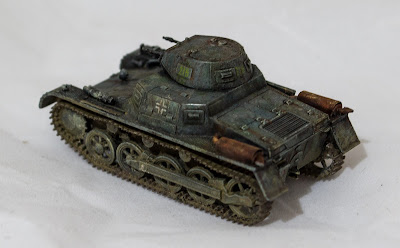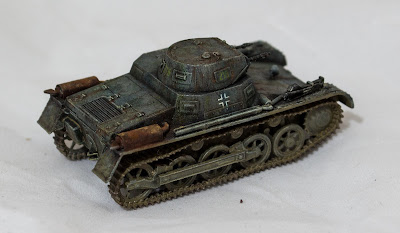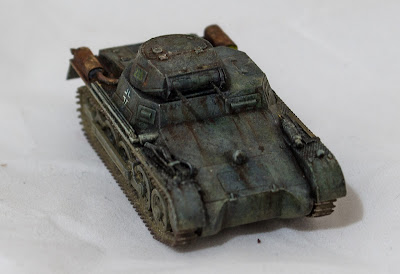When a box full of kits came from Erhan Atalay, I opened it with excitement and saw 2 tiny Panzers. One of them was this tiny Panzer 1 and the other was a Panzer 2. Since I've never made an S-Model kit before, I excitedly took the two together on the bench and started to assembly them.
The kit is very tiny, but they put etched pieces inside. When these parts are added, the model looks really nice. Would I be exaggerating if I said that the barrels were also metal?
The tracks of the kit are given as one piece. These kind of tracks are my favorite kind. But there were mold marks on the tracks that were very hard to reach. No matter how hard I tried, I couldn't completely scrape it off.
I wanted to find and add a bucket to the etched part on the back of the tank, but unfortunately, such parts are impossible to find at this scale. I didn't make a bucket at this scale since it's too small and left the piece as it is.
It was a very easy kit to assemble and I completed it quickly. I also assembled and primed the Panzer 2 at the same time. The primer actually slightly overshadowed the beauty on the etched pieces. But these parts do not hold paint without primer. That's why I had to prime.
The primer immediately reveals the mistakes you made on the model. Especially the gray primer is very good in this regard. I fixed the faulty parts that appeared after the primer. In general, I did not see any assembly errors on the kit. I really liked the S-Model in this regard.
Since these tanks were used in the early stages of the Second World War, it is necessary to paint them with either African camouflage or panzer gray. I preferred panzer gray, as I often do lately.
First, I painted the entire model with panzer gray. Since this color seems too dark to me, I applied blue gray paint with a sponge. Then I dry brushed the protruding parts by lightening the gray with white.
I wonder how I used to make models without dry brushing. It is a good feeling to improve one's self by making models. After the dry brushing was finished, I painted the items on the tank.
There was not much detail on the tank that needed extra paint. I painted the tracks and the exhaust in rust color and the tools on the tank in anthracite. I also painted the barrels in anthracite color. The painting of the tank is finished as it is.
For this model, I used decals from other kits since I did not have decals at hand. In fact, I wish I had the signs on which panzer division this tank belongs to. But this time, unfortunately, I didn't have any decals for it.
I fixed the decals between 2 coats of glossy varnish. If we do not want the decals to shine, we need to do this application. Otherwise, the decals look like they are glued onto the tank rather than painted.
Recently, I have been applying oil paint on models. Oil paint application beautifies and naturalizes the appearance of tanks. I am very happy to learn these methods. This is the part that I have enjoyed the most while modeling lately.
First, I applied a filter on the tank using 3 different colors. This application takes the shine of the paint and fades the color. It mattifies the tank but does not darken the color if you use the right colors. That's why the filter is so important. The only thing to be careful about is not to fill the hollow parts completely. Otherwise, our dye cannot enter these areas while washing.
After the filter, I put dots in green, yellow and brown colors, with white being dominant on the tank. Then I spread these paints over the entire surface of the tank using white spirit. With this application, different colors appear at different points and the model comes out of monotony. It is very important to break the monotony in monochrome tanks.
It is very important to dry the tank after oil paint application. Otherwise, at each stage, you will delete what you did in the previous stage. After the entire application was finished, I once again covered the tank with gloss varnish.
After applying glossy varnish, I washed the tank with black oil paint. Washing is an application that adds volume to the tank, but you need to be careful while doing it. Otherwise you will paint the whole tank black. I love the washing application part.
After the washing was finished and the tank was dry, I applied a matte varnish on it. Since the matte varnish is grainy, it facilitates the aging process. It also prevents the underlying paint from being damaged. But if you apply too much, the tank can look like a toy.
I first applied mud and dust to the tracks, front and rear surfaces of the tank. I painted the parts of the tracks that touched the ground with a metallic color. Finally, I applied pigments and finished with the tracks.
I made streaks to the top of the tank first. I made the streaks with rust color and streaking grime. At this scale, one has to be very careful. Because if you don't thin them well, they can be very thick according to the scale.
I made a rust effect on the handles on the tank. I also aged a few corners with a sponge. This application provides a natural look on the tank. I made a metallic wear effect by rubbing a pencil on the sides of the tank.
I weathered the vehicle's exhausts with rust pigments. This rust application completely breaks the monotonous appearance on the tank. But since the sizes are small, the pigments smudged a little.
























































